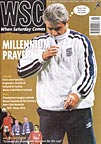 Dominic Smith attended England v Scotland and got a view of the two differing types of England fan
Dominic Smith attended England v Scotland and got a view of the two differing types of England fan
It’s been a few years since I watched a group of England fans – all replica shirts, union flags and Blackburn Rovers tattoos – follow a middle-aged woman down Wembley High Road, jeering and repeatedly calling her a “Paki”. Part of the dark old days which the FA and the media – all eagerly campaigning for the English 2006 World Cup bid – would have us believe are long gone.
The halcyon days of Euro 96 saw the racist, swaggering thugs with their menacing demeanour and National Front pin badges replaced in the public consciousness by a new kind of England fan – the fair-minded supporters who painted their faces, sang along to Football’s Coming Home whether we won or lost and posed for souvenir photos with kilt-wearing Scots or the orange-clad Dutch.
But watching England entertain Scotland at Wembley proved that, while the sentiments of the abusive mid-Eighties England fan may have been masked by the community spirit of following New England, they still bubble away uneasily below the surface. The derisive booing of Flower of Scotland was inevitable given the Scots’ reaction to God Save The Queen at Hampden. But the nature of the abuse still surprised me.
While many around me booed the Scottish anthem almost as a self-conscious joke, aware that it was only a half-serious response to Hampden’s treatment of “England’s” anthem, there were many others who were not laughing. Their faces were contorted with rage as they screamed abuse at the Scottish supporters, who were grouped at the opposite end of the ground and massively out of range.
Even more worrying was the ease with which this anti-Scottish feeling was able to drift into physical violence. The first sign of this came outside Wemb- ley where, approaching the ground, I heard the first strains of “No Surrender”, the chorus intimately associated with impending English violence. Two Scottish fans, walking towards the stadium in full traditional dress, were repeatedly insulted by two England fans wearing the usual oversized jackets and baseball caps.
The Scots – both in their late thirties – were doing their best to continue on their way when one of the abusers piled in with a shoulder barge and attempted to pin him to the fence. Again the Scots walked on, any further discomfort prevented by an England fan who sent two uniformed police across to sort it out.
Inside the ground it was the Scottish goal, predictably, that changed the atmosphere. As Hutchison’s header hit the net a few isolated cheers went up around us, an area that was populated almost exclusively by men in their twenties and thirties. Instantly groups of England fans stood up attempting to spot the celebrating Scots. One steward moved quickly to remove a Scottish fan, but even as the fan stood up he was grabbed by his collar and yanked backwards by an England fan two rows behind attempting to get at him.
Another Scot two rows in front of us was screamed at by a six-foot England supporter. When he returned the abuse the England fan started down the row to get at him. There then followed a five-minute tussle between six-footer and his mate, who attempted to halt his attack on the Scottish fan. He, thankfully, now decided to sit down and belt up. Another Scottish fan caught a glancing blow to the chin as he nipped out of his seat and ran for the exit.
All in all it was a night when English football failed to cover itself in glory on and off the pitch. The majority of the crowd were there to watch the game in an honest, law-abiding fashion but there was still a significant number who would gladly have furthered the reputation of Old England, the England that all parties to the 2006 bid would rather pretend no longer existed.
Has the nature of the Wembley crowd improved since the bad old days? Yes. Could I confidently predict the safety of outsiders sitting among the England fans? No. Anyone who has attended England matches at Wembley in the Eighties and since Euro 96 will know that there has been an improvement. The nature of the vast majority of England’s home support has changed significantly since the days of those racist Blackburn fans, but it hasn’t changed completely. There’s still a long way to go.
From WSC 155 January 2000. What was happening this month